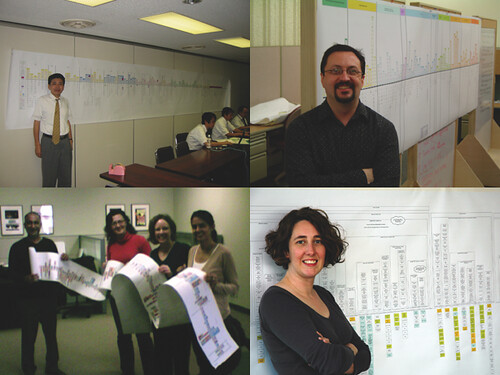Image from Flickr
How do we make the data actionable? We get lot of data in form of demographics and our audience. “12% of movie goers preffer to go movies alone.†How do we figure out what to do with this piece of data?
Answering questions about Mental models. What’s a mental model, how do I use it, how do I decide to make a model, or not? Etc.
What is a mental model?
It’s a diagram of underlying reasons that drive people’s behavior. You match it in the ways you support people with your product.
What does a mental model look like?

Source: Rosenfeld media @ flickr
[It’s a long piece of paper, long narrow diagram]
Mental models are very closely tight to the kinds of audience you’re designing for.
—
Above the line, you have little boxes that describe: behavior, philosophy, feeling
Then you group them in a “tower†– conceptual group. You get a sort of skyline. A lot of people’s voices can be represented in the boxes and then combining all the towers together in mental spaces. The language above the line are verbs and it’s really colloquial.
Bellow the line, there are ways to support the tower.
Purple below the line – a pretty strong connection between product and what people are trying to do with the tower.
White box below the line – kind of aligned but not really.
You get data on top of data by using:
Diaries
- Field data
- Interviews
- Customer feedback
- Call center recording
- Card sort data
- Voice of the customer
Mental models sits inside the nest of all the other user experience processes. You can make personas, scenarios and all sorts of task based audience separation out of it. It’s just a different visualization that keeps track of things.
- Mental models show people that they need to develop separate application for separate sets of people.
- The other ulterior motive, actually get things slated for the mythical phase 2.
- Focus on customers, not internal organizations/categories
- Get rid of stuff that doesn’t help.
- Give stakeholders something that feels actionable.
—
Can it resolve some of the problems my team has?
Problem: We struggle to agree on a common design (everyone has a different opinion)
Mental model is an independent research model, that allows you to agree on interpretations of the field data.
Problem: We have difficulty taking off our employee hat
Helps you figure out what customers want.
Problem: We cross our fingers that the design will be successful
Mental models helps you in a way that gives you lots of confidence up at the start.
Problem: we worry we might have missed some part of the “whole user experienceâ€
Problem: we wish we could attract loyal, adoring fans.
Mental models solve all this 😉

Source: Rosenfeld media @ flickr
We all hear stories, and when we hear a story, it helps us understand a situation that this person is in. And when you emphasize with someone, you can play their role and then you can understand the depth at which they are operating and it makes your decisions much easier.
Hear stories -> Feel empathy -> Deep understanding
—
How do I decide to make a mental model, or not?
It’s a “generative type of researchâ€, it’s an mental environment in which things get done. You want it to use it for your Interaction design.
Mental models are Not Used for:
- Evaluating usability
- Showing cyclical relationships
- Depicting detailed process flow
- Creating art (composing, painting, …)
What do I put in a mental model?
Behavior, philosophy, feeling   vs. Direct, implied, third party. You need to have good skills at reading between the lines.
Why focus on emotion?
“Distrust†is an emotion and it’s something that is really important to be aware of.
The hallway test: “what is she thinking while walking down the hallway.†Trying to focus on a higher level: “I’ve got to get report done, or I won’t be able to go to the movies.â€
How can I do this by myself?
Yes, there are number of shortcuts you can use:
- Rough sketch
- Rough draft: 1 day, 1 conference room, lots of coffee and chocolate
- Rough notes: do your analysis on the fly, while you’re talking to people. You write tasks, and emotions on sticky notes on the fly.
- Fly Under the Radar
- Piggyback on Other Research: add another half-hour to User research
How do mental models fit the agile principles:
- Synchronize UX with development
- Separate modeling from design
- Increase design literacy
- Design on the whiteboard with developers, stakeholders
- Strip documentation
- [One more]
How can I use mental model to innovate?
Innovation is something that is not forced. It’s something that is understandable, when you make a brand new flashlight, people won’t get it since it’s too different. Innovation occurs while you’re crafting details. The innovation needs to focus on people, and it’s long term.
Look at the mental model for possibilities:
- Find a gap below the line to fill
- Look for scarce of Weak Support
- Redefine & augment existing features to better match
- Combine related behaviors and features
- Look for surprises
- Look for emotions
- Examine spaces formerly crossed out
- [Two more]
===
Book: Mental models


wow you’re quick!
would love to get the book now 🙂
WOW, like the subject – didn’t quite understand it, will order a book… Do u have any other good resources?